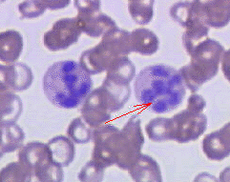- Megaloblastic anemia
-
Megaloblastic anemia Classification and external resources 
Peripheral blood smear showing hypersegmented neutrophils, characteristic of megaloblastic anemia.ICD-10 D51.1, D52.0, D53.1 ICD-9 281 DiseasesDB 29507 eMedicine med/1420 ped/2575 MeSH D000749 Megaloblastic anemia (or megaloblastic anaemia) is an anemia (of macrocytic classification) that results from inhibition of DNA synthesis in red blood cell production.[1] When DNA synthesis is impaired, the cell cycle cannot progress from the G2 growth stage to the mitosis (M) stage. This leads to continuing cell growth without division, which presents as macrocytosis.
The defect in red cell DNA synthesis is most often due to hypovitaminosis, specifically a deficiency of vitamin B12 and/or folic acid. Vitamin B12 deficiency alone will not cause the syndrome in the presence of sufficient folate, for the mechanism is loss of B12 dependent folate recycling, followed by folate-deficiency loss of nucleic acid synthesis (specifically thymine), leading to defects in DNA synthesis. Folic acid supplementation in the absence of vitamin B12 prevents this type of anemia (although other vitamin B12-specific pathologies continue).
Megaloblastic anemia not due to hypovitaminosis may be caused by antimetabolites that poison DNA production directly, such as some chemotherapeutic or antimicrobial agents (for example azathioprine or trimethoprim).
The pathological state of megaloblastosis is characterized by many large immature and dysfunctional red blood cells (megaloblasts) in the bone marrow[2] and also by hypersegmented neutrophils (those exhibiting five or more nuclear lobes ("segments"), with up to four lobes being normal). These hypersegmented neutrophils are found in the "peripheral blood" (i.e., a diagnostic smear of a blood-sample taken from the circulation).
Contents
Causes
- Vitamin B12 deficiency leading to folate deficiency:
- Achlorhydria-induced malabsorption
- Deficient intake
- Deficient intrinsic factor (pernicious anemia or gastrectomy)
- Celiac disease
- Biological competition for Vitamin B12 by diverticulosis, fistula, intestinal anastomosis, and infection by the marine parasite Diphyllobothrium latum (fish tapeworm)
- Selective Vitamin B12 malabsorption (congenital—juvenile megaloblastic anemia 1—and drug-induced)
- Chronic pancreatitis
- Ileal resection and bypass
- Nitrous oxide anesthesia (usually requires repeated instances).
- Folate deficiency:
- Alcoholism
- Deficient intake
- Increased needs: pregnancy, infant, rapid cellular proliferation, and cirrhosis
- Malabsorption (congenital and drug-induced)
- Intestinal and jejunal resection
- (indirect) Deficient thiamine and factors (e.g., enzymes) responsible for folate metabolism.
- Combined Deficiency: Vitamin B12 & folate.
- Inherited Pyrimidine Synthesis Disorders: Orotic aciduria
- Inherited DNA Synthesis Disorders
- Toxins and Drugs:
- Folic acid antagonists (methotrexate)
- Purine synthesis antagonists (6-mercaptopurine)
- Pyrimidine antagonists (cytosine arabinoside)
- Phenytoin
- Nitrous Oxide
Hematological findings
The blood film can point towards vitamin deficiency:
- Decreased red blood cell (RBC) count and hemoglobin levels[3]
- Increased mean corpuscular volume (MCV, >95 fl) and mean corpuscular hemoglobin (MCH)
- Normal mean corpuscular hemoglobin concentration (MCHC, 32–36 g/dL)
- The reticulocyte count is decreased due to destruction of fragile and abnormal megaloblastic erythroid precursor.
- The platelet count may be reduced.[citation needed]
- Neutrophil granulocytes may show multisegmented nuclei ("senile neutrophil"). This is thought to be due to decreased production and a compensatory prolonged lifespan for circulating neutrophils, which increase numbers of nuclear segments with age.[citation needed]
- Anisocytosis (increased variation in RBC size) and poikilocytosis (abnormally shaped RBCs).
- Macrocytes (larger than normal RBCs) are present.
- Ovalocytes (oval-shaped RBCs) are present.
- Howell-Jolly bodies (chromosomal remnant) also present.
Blood chemistries will also show:
- In increased lactic acid dehydrogenase (LDH) level. The isozyme is LDH-2 which is typical of the serum and hematopoetic cells.
- Increased homocysteine and methylmalonic acid in Vitamin B12 deficiency
- Increased homocysteine in folate deficiency
Normal levels of both methylmalonic acid and total homocysteine rule out clinically significant cobalamin deficiency with virtual certainty.[4]
Bone marrow (not normally checked in a patient suspected of megaloblastic anemia) shows megaloblastic hyperplasia.
Analysis
The gold standard for the diagnosis of Vitamin B12 deficiency is a low blood level of Vitamin B12. A low level of blood Vitamin B12 is a finding that normally can and should be treated by injections, supplementation, or dietary or lifestyle advice, but it is not a diagnosis. Hypovitaminosis B12 can result from a number of mechanisms, including those listed above. For determination of etiology, further patient history, testing, and empirical therapy may be clinically indicated.
A measurement of methylmalonic acid can provide an indirect method for partially differentiating Vitamin B12 and folate deficiencies. The level of methylmalonic acid is not elevated in folic acid deficiency. Direct measurement of blood cobalamin remains the gold standard because the test for elevated methylmalonic acid is not specific enough. Vitamin B12 is one necessary prosthetic group to the enzyme methylmalonyl-coenzyme A mutase. Vitamin B12 deficiency is but one among the conditions that can lead to dysfunction of this enzyme and a buildup of its substrate, methylmalonic acid, the elevated level of which can be detected in the urine and blood.
Due to the lack of available radioactive Vitamin B12, the Schilling test is now largely a historical artifact.[citation needed] The Schilling test was performed in the past to help determine the nature of the vitamin B12 deficiency. An advantage of the Schilling test was that it often included Vitamin B12 with intrinsic factor.
See also
- List of circulatory system conditions
- List of hematologic conditions
- Megaloblastic Anemia
External links
References
- ^ "Megaloblastic Anemia: Overview - eMedicine Hematology". http://emedicine.medscape.com/article/204066-overview. Retrieved 2009-02-07.
- ^ "Megaloblastic (Pernicious) Anemia - Lucile Packard Children's Hospital". http://www.lpch.org/DiseaseHealthInfo/HealthLibrary/hematology/megalob.html. Retrieved 2008-03-12.
- ^ http://www.nlm.nih.gov/medlineplus/ency/article/000567.htm MedlinePlus: Megaloblastic Anemia, "Megaloblastic anemia is a blood disorder in which there is anemia with larger-than-normal red blood cells. Anemia is a condition in which the body does not have enough healthy red blood cells. Red blood cells provide oxygen to body tissues."
- ^ Savage DG, Lindenbaum J, Stabler SP, Allen RH (1994). "Sensitivity of serum methylmalonic acid and total homocysteine determinations for diagnosing cobalamin and folate deficiencies". Am. J. Med. 96 (3): 239–46. doi:10.1016/0002-9343(94)90149-X. PMID 8154512. http://linkinghub.elsevier.com/retrieve/pii/0002-9343(94)90149-X.
Categories:- Nutritional anemias
- Hematopathology
- Vitamin B12 deficiency leading to folate deficiency:
Wikimedia Foundation. 2010.
